Sherman Park Neighborhood
Introduction
Text-to-speech Audio
The Sherman Park neighborhood of Milwaukee, Wisconsin is the location where, in 2016, Sylville Smith was shot by and killed by Officer Dominique Heaggan-Brown. This community in Milwaukee has a very diverse history that dates back to the late 1800s. The murder of Smith, who was armed and running away form the officer, led to extreme civil unrest in the community. Three days of protests and riots took place in this neighborhood, resulting in injuries, burned vehicles and buildings, and a dark cloud over the community for years to come. The officer involved in the shooting was found innocent and the charges were acquitted but later spent time in prison for sex crimes and is now a registered sex offender in Milwaukee. He no longer works for the Milwaukee Police Department.
Images
Here are two maps that show exactly where Sherman Park is located. Milwaukee is a city made up of over 150 distinct neighborhoods which are broken into broader areas. The first map shows how some of these neighborhoods are broken up. The second map shows exactly where Sherman Park is located, right in the middle of Milwaukee. You can see that it borders an expressway (41). For a period of time, a lot of the neighbrohood was going to be deconstructed to make it into an industrial neighborhood because it was so close to the expressway. The people of Sherman Park put together a task force to put an end to this. Because it still borders this expressway, it is an area that could experience a lot of out of town visitors. That can increase the crime rate in a neighborhood. The people of Sherman Park have always stayed close even though they are very different from each other.
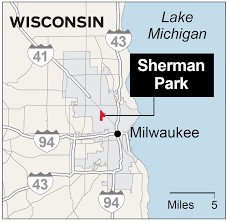
Here is a picture from the bodycam footage of a police officer shooting Sylville Smith. Sylville appears to be armed having a gun in his right hand. He is running away from police. The reason this picture is important is because it relates to the killing of Dontre Hamilton just 2 years earlier in a nearby neighborhood, Red Arrow. Hamilton was shot 14 times by a police officer. Both police officers in the Hamilton and Smith shootings were either not charged or found innocent. Hamilton’s killing led to the requirement of police in Milwaukee to wear body cams, so that is why we are able to see this footage today.
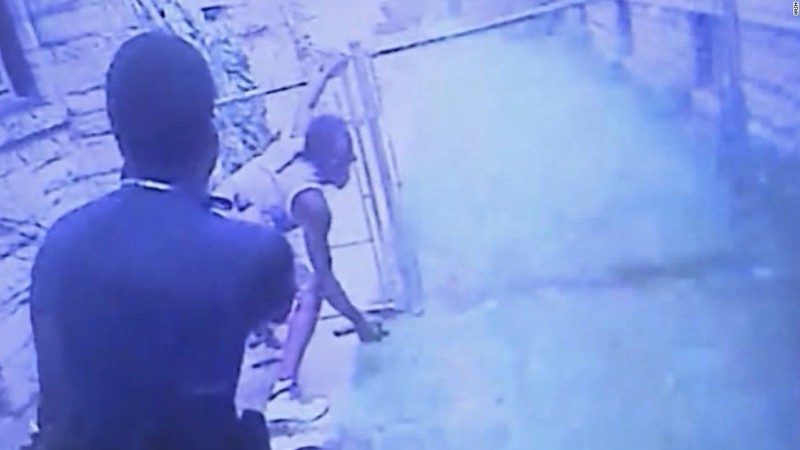
Here are two maps that show exactly where Sherman Park is located. Milwaukee is a city made up of over 150 distinct neighborhoods which are broken into broader areas. The first map shows how some of these neighborhoods are broken up. The second map shows exactly where Sherman Park is located, right in the middle of Milwaukee. You can see that it borders an expressway (41). For a period of time, a lot of the neighbrohood was going to be deconstructed to make it into an industrial neighborhood because it was so close to the expressway. The people of Sherman Park put together a task force to put an end to this. Because it still borders this expressway, it is an area that could experience a lot of out of town visitors. That can increase the crime rate in a neighborhood. The people of Sherman Park have always stayed close even though they are very different from each other.
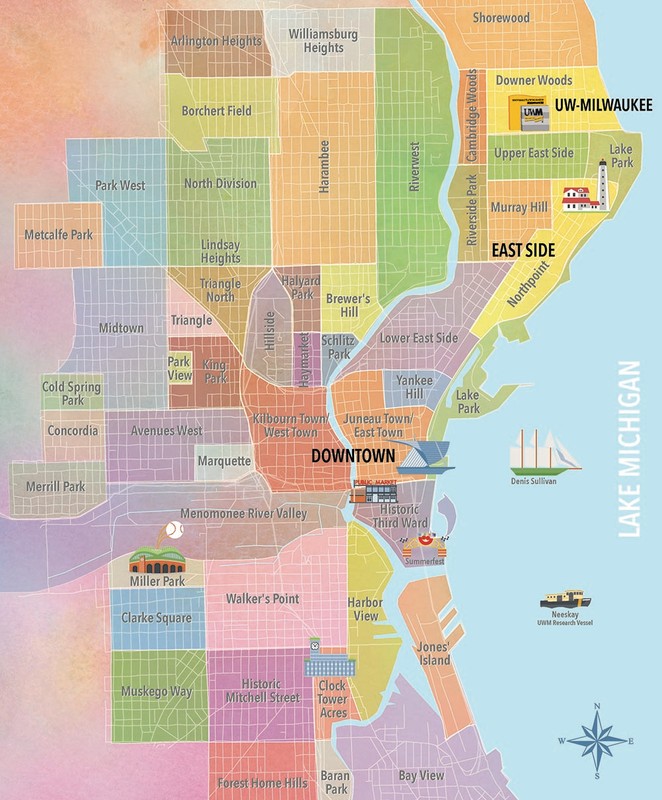
Here is another photo taken not too long after the riots. You can see that police are still present and in full riot gear while there are other community members walking by and going about their business. The riots in 2016 changed the way Sherman Park was viewed. It used to be known for its diverse and welcoming community but now the police presence in response to the riots has made it a neighborhood that is not nearly as friendly. Interestingly, the riots took place due to a police officer killing a Black man.
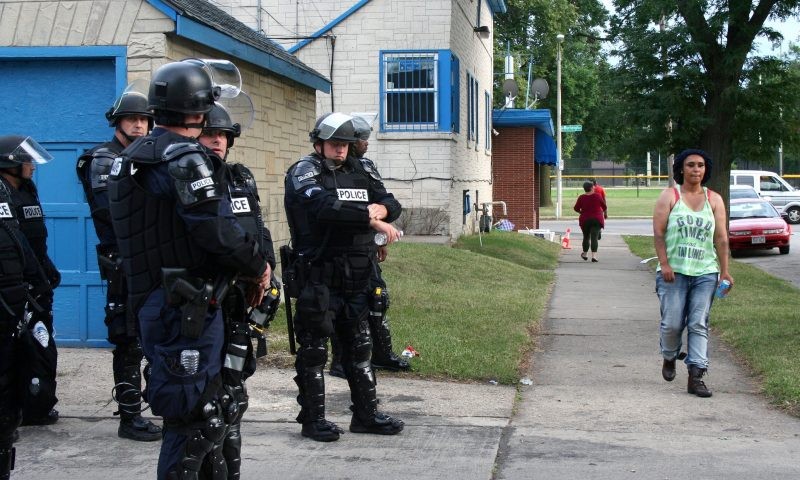
Here is a photo after the three days of riots that occurred at Sherman Park following the killing of Sylville Smith. You can see that cars were burned and a lot of the area was torn up. The protests turned violent and turned into riots. They lasted for three full days which brought a lot of national news media attention to the area.
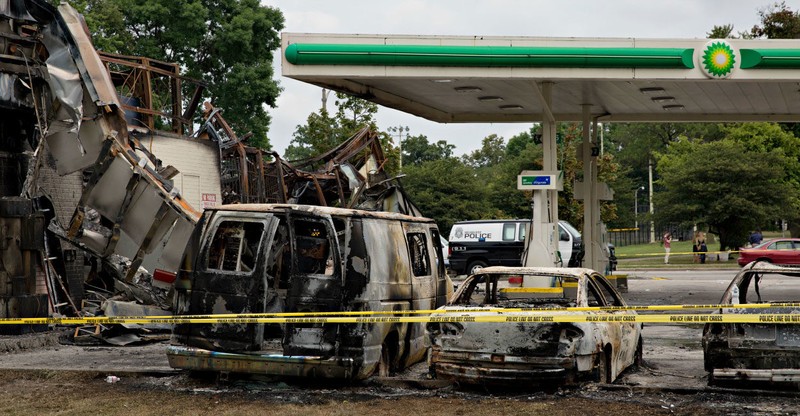
This is a photo of Sherman Park from 1963. During this time the African Americans faced discriminatiton in accessing housing and available living. Sherman Park served as a place where African American families could move and be part of the desegregation of the Milwaukee community. They would be surrounded by people who were from other cultures, such as the Irish, English, Polish, and Jewish.
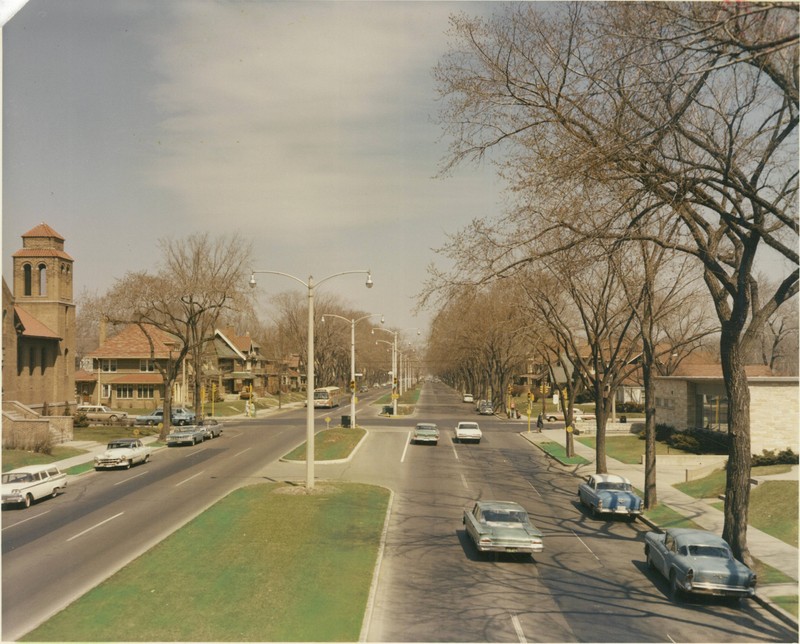
Here is a picture of Sylville Smith’s family a few years after his murder. After the riots calmed down, the family came together to raise awareness for the killing of their family member by a police officer. You can see here that the family is still very much impacted by Smith’s murder. You can also see people from various racial backgrounds in the photo, showing the diversity and community of Sherman Park. Some of the people are also wearing masks, showing that this photo was taken during the Covid 19 pandemic.
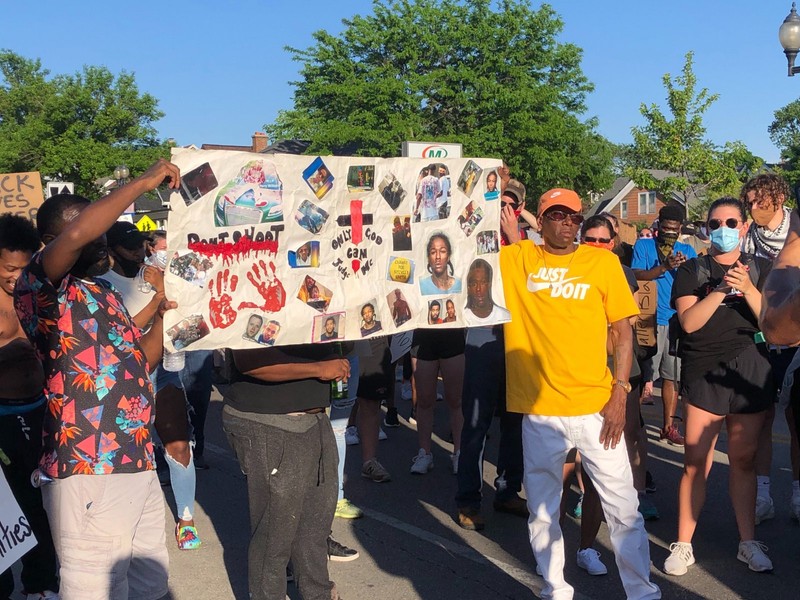
Here is a photo of the installation of the memorial bench for Dontre Hamilton at a park in Red Arrow, a neighborhood in Milwaukee. Dontre Hamilton was shot 14 times by police and the officer was not charged with anything. He was fired from his job instead. It is important that the Sherman Park community and Milwaukee do something like this in remembrance of Sylville Smith. No memorial has been created at this time even though the family is in the process of receiving a significant settlement. A memorial like this would remind the neighborhood of Sherman Park that they are united against police brutality and racism and are a welcoming place for people of all different backgrounds.
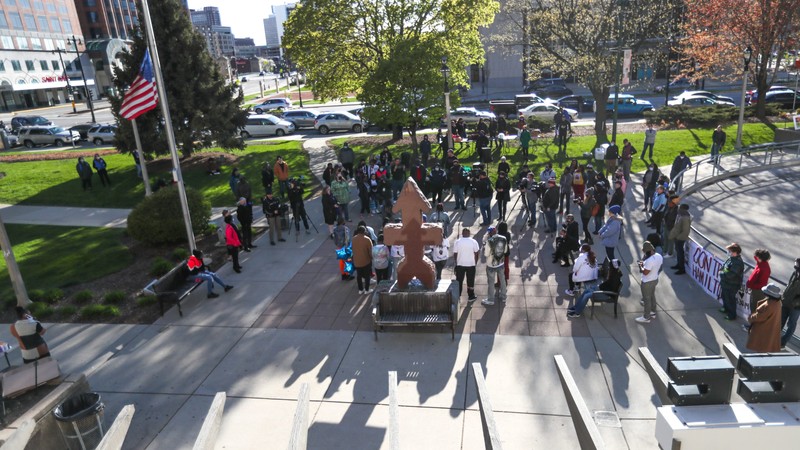
Backstory and Context
Text-to-speech Audio
While the community of Sherman Park has not always been an area that received a lot of attention, an event happened in 2016 where the neighborhood was all over the news. In August of 2016, Sylville Smith, a Black man from the neighborhood, was fatally shot and killed by local Milwaukee policeman in the area. According to reports, Sylville was someone with a criminal background and the police were trying to arrest him. His criminal record was extensive and dated back to 2011, with eight different charges of robbery. At the time of his murder, he was armed and ran away, but once the police officers caught up with him, he was shot and killed. Prior to the murder, Smith was involved in an altercation with the police officer, who he and his family knew. The officers stated that as he was running away and they approached him, he was drawing his weapon towards them. The killing of Sylville Smith led to three nights of protests, riots, and extreme social unrest in the community. These happenings made Sherman Park a much more well-known location. While the officer was acquitted of charges, the city of Milwaukee is in the works of offering the family a $4 million settlement. Later, the officer was convicted of sex crimes and spent time in prison.
Just a couple of years earlier, in 2014, another Black man was killed by police in a nearby neighborhood, Red Arrow. Dontre Hamilton, a mentally ill individual, was shot fourteen times by a police officer just two years before Smith’s murder. The officer who killed Hamilton was fired from his job, but not charged with anything. Even though he didn’t get charged, the case led to the use of body cameras with the Milwaukee PD. Because of this case, Milwaukee police were wearing body cameras when they killed Sylville Smith.
Another reason the Hamilton killing ties to Sherman Park is because of the memorial that was created. In 2021, the city of Milwaukee allowed for a bench to be installed in Red Arrow Park in memory of Dontre Hamilton. To this day, nothing has been put in place for Sylville Smith, but there is a perfect park area within Sherman Park that would be a great place for this.
Sherman Park has a lot of historical content. In the 1890s German residents from the Northside began building homes in the farmland west of the railroad line that ran parallel to 31st street in Milwaukee, Wisconsin. The neighborhood where they resided became known as Sherman Park. Historically, this neighborhood has been known as an industrial area home to European immigrants, with people of different cultures migrating and expanding the diversity in that specific area. In the years that followed, many immigrants came to the area, including people from Ireland, Poland, England, and Jewish people escaping the unrest in Europe at the time. The home lots in this area were bigger than most, and people used a really popular stone in the area, Lannon stone, to build strong, sturdy homes. The neighborhood was affected by neighborhood planning and desegregation over the years and became known as a place for middle-class families. After World War II, a significant number of African-American families relocated to the area as well. In the 1960’s and 1970’s, gentrification started to take place and the area was turned into a more industrial area by the city so homes lost value. Individuals in the community formed a task force to stop the building of a freeway in the area and also to increase integration in the schools. In addition, six Jewish synagogues were built there. All of these examples show that Sherman Park has been and continues to be a very diverse neighborhood in the city of Milwaukee, Wisconsin.
Overall, Sherman Park is a neighborhood that has a lot of character in the Milwaukee area. The historical significance of this place as a neighborhood that brought people together from all different backgrounds and tolerated and accepted these differences makes it worth looking into deeper. Unfortunately, an event in 2016 where a Black man was killed by police officers led to protests and riots in a place that was peaceful most of the time. These riots and protests received attention from the national news. By adding a memorial for Sylville Smith at the actual park in Sherman Park, the city of Milwaukee can continue to make sure the community stays diverse and welcoming as an important part of the entire city.
Sources
•https://shermanpark.org/
•https://historicmilwaukee.org/doors-open/neighborhoods/sherman-park/
•https://emke.uwm.edu/entry/sherman-park/
